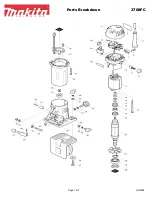
Release
15mm Mounting
10mm Mounting
5mm Mounting
3mm Mounting
Low-Prs Laminating
Mid-Prs Laminating
High-Prs Laminating
(G)
(H)
(I)
(J)
(2)
(1)
(N)
(1)
(2)
+
-
(1)
(2)
(M)
(L)
(K)
11
G. ROLLER HANDLE: (Figure 15)
The roller handle manually sets the
position of the pull rollers while
simultaneously electronically setting
the main rollers.
Available settings are;
– Release
– 15mm Mounting
– 10mm Mounting
– 5mm Mounting
– 3mm Mounting
– Low-Prs Laminating
– Mid-Prs Laminating
– High-Prs Laminating
(Prs = pressure)
H. IDLER BAR: (Figure 16) The idler
bars, located near each heat roller,
are used to direct the film to the
heat roller nip.
I. CHILL IDLER: (Figure 16) Assist
in the cooling process of the web
material as it exits the heat rollers.
To engage the chill idler, grip the
chill idler handles located on each
side of the chill idler and lower to
the web position (1). To disengage
the chill idler, move the chill idler to
it’s rest position (2).
J. COOLING FANS: (Figure 16)
Assist in the cooling process by
pushing unheated air onto the web
material as it exits the heated
rollers. This feature can be
controlled from the control panel.
K. FILM SHAFT: (Figure 17) The
film shaft holds the film supply on
the machine.
To remove the film shaft, lift up on
the round end (1) of the unwind/
rewind shaft then pull the hex end
(2) of the shaft out and away from
the laminator.
L. CORE ADAPTORS: (Figure 17)
Hold and lock the rolls of film on the
shafts to prevent side to side
shifting.
M. LOWER SHAFT LOCK: (Figure
17) Secures the left side of the
lower shafts. To remove a shaft,
turn the outer dial (1) opening so it
aligns with the inner u-channel (2)
opening and lift up and out.
N. UNWIND/ REWIND TENSION:
(Figure 17) Used to apply resis-
tance to the film shaft.
To increase film shaft tension, turn
the film shaft tension knob
clockwise. Counter clockwise will
decrease film shaft tension.
Fig. 15
Fig. 16
Fig. 17












































